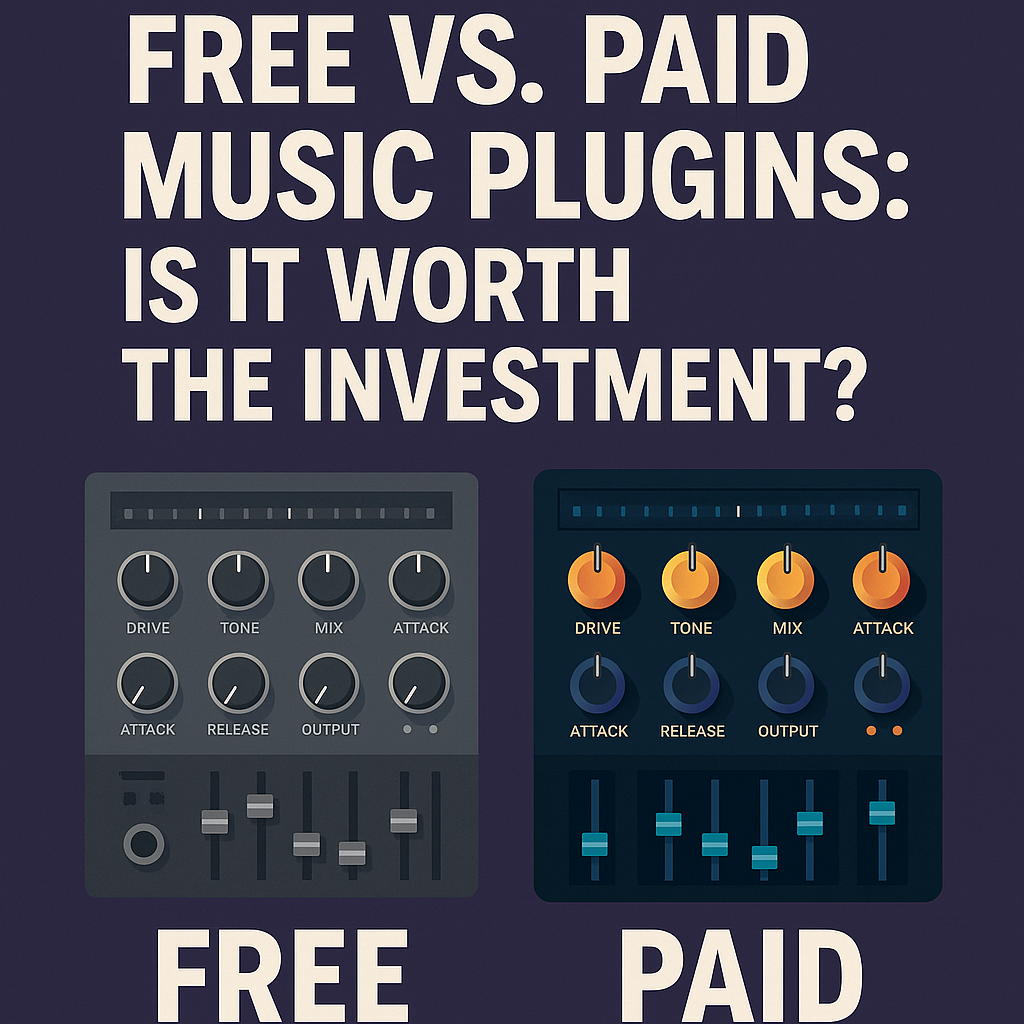Music production has never been more accessible, thanks to a vast ecosystem of plugins—virtual tools that shape, process, and create sound inside your DAW. Whether you’re a bedroom producer or a seasoned professional, the question inevitably arises: should you rely on free plugins, invest in premium ones, or use a mix of both? This comprehensive guide explores the realities of free vs. paid music plugins, helping you decide where your money and creative energy are best spent.
What Are Music Plugins?
Music plugins are software components that add new features or effects to your digital audio workstation (DAW). They come in various formats (VST, AU, AAX) and include:
Virtual instruments (synths, samplers, drum machines)
Audio effects (EQ, compression, reverb, delay)
Utility tools (meters, analyzers, workflow enhancers)
The Case for Free Plugins
Advantages
Cost-Effective: Free plugins are perfect for those on a tight budget or just starting out. There’s no financial risk in trying them, and many offer impressive features at no cost.
Diverse Selection: The internet is full of free plugins, ranging from basic utilities to creative sound design tools. Some, like Spitfire Audio Labs or Voxengo, are highly regarded for their quality.
Lightweight and Accessible: Free plugins often have fewer features, making them less demanding on your computer’s resources—ideal for older or less powerful systems.
Limitations
Limited Features: Free plugins typically offer a basic set of controls. Advanced functions like multi-band processing, side-chaining, or deep modulation are often missing.
User Interface: Many free plugins have clunky or outdated interfaces, which can slow down your workflow and make complex tasks more difficult.
Support and Updates: Free plugins rarely come with customer support or regular updates. If bugs occur, you may have to wait a long time (if ever) for fixes.
Sound Quality: While some free plugins sound great, premium plugins usually offer superior algorithms and modeling, especially noticeable in critical mixing and mastering tasks.
“Free VST plugins are addictive… But here’s the hard truth: free plugins are almost never as good as their paid counterparts.”
— LANDR Blog
Popular Free Plugins (Images & Demos)
- Spitfire Audio LABS :
Free orchestral and ambient instruments
A collection of high-quality, free virtual instruments — perfect for cinematic, ambient, and orchestral compositions.
- Voxengo Span :
Free spectrum analyzer for mixing and mastering
An essential tool for visualizing frequency content in your mix. Ideal for producers aiming for professional sound balance.
- TAL-Reverb-4:
Lush reverb for vocals and synths
A vintage-style plate reverb with a smooth and deep character — great for adding space to your sounds.
Subscription-Based Plugins: A Middle Ground
Subscription models offer access to a library of premium plugins for a monthly fee, often around $15–$20. This allows you to use top-tier tools without a huge upfront investment and always have access to the latest updates and releases.
Ideal for:
Freelancers and project-based producers who need flexibility
Beginners wanting to experiment with a wide variety of tools
Professionals who want the latest technology without large one-time payments
Free vs. Paid Plugins: Feature Comparison
| Feature | Free Plugins | Paid Plugins |
|---|---|---|
| Cost | Free | $50–$500+ per plugin, or subscription |
| Features | Basic to moderate | Advanced, innovative, hardware emu |
| Sound Quality | Good, sometimes excellent | Generally superior, pro-grade |
| Support & Updates | Rare, community-based | Regular, professional |
| User Interface | Varies, often basic | Polished, intuitive |
| Learning Resources | Limited, community-driven | Extensive manuals, tutorials |
| Reliability | Can be buggy, less maintained | Frequently updated, stable |
When to Use Free Plugins
You’re a beginner: Free plugins are perfect for learning the basics without financial risk.
Budget constraints: If you can’t afford premium tools, free plugins can still deliver great results.
Experimentation: Free plugins are ideal for trying out new sounds and creative effects without commitment.
Lightweight needs: For simple tasks or on older computers, free plugins are often more efficient.
When to Invest in Paid Plugins
Professional projects: If you’re working for clients or releasing commercial music, the sound quality and reliability of paid plugins can make a difference.
Need for advanced features: When your music demands side-chaining, multi-band processing, or hardware emulation, premium tools are often necessary.
Workflow efficiency: Paid plugins with intuitive interfaces and better support can speed up your production process.
Long-term investment: If music production is your career or serious hobby, high-quality plugins are worth the investment.
Common Myths and Realities
Myth: Free plugins are always inferior.
Reality: Many free plugins rival paid ones in sound and features, but the best paid plugins still set the standard for innovation and quality.
Myth: Buying more plugins will make your music better.
Reality: Mastering a few well-chosen tools (free or paid) is more effective than amassing dozens you barely use.
Expert Tips for Choosing Plugins
Assess your needs: Don’t buy plugins just because they’re on sale or hyped. Identify your production gaps first.
Try before you buy: Many paid plugins offer demos. Test them in your workflow before committing.
Mix and match: Use free plugins for routine tasks and paid ones for specialized needs.
Stay organized: Keep your plugin folder tidy to avoid “option paralysis.”
Learn your tools: Deep knowledge of a few plugins is more valuable than shallow familiarity with many.
Best of Both Worlds: Hybrid Approach
Most producers use a combination of free and paid plugins. Free plugins handle basic EQ, compression, and utility tasks, while paid plugins tackle advanced processing, creative effects, or emulate classic hardware.
Conclusion: Is It Worth the Investment?
The answer depends on your goals, budget, and experience level:
Beginners and hobbyists: Start with free plugins. They’re more than enough for learning and experimentation.
Serious producers and professionals: Investing in a few high-quality paid plugins can elevate your sound and workflow.
Everyone: Don’t overlook the power of free plugins. Use them alongside paid tools for maximum flexibility and creativity.
Ultimately, the best investment is in your skills and creativity. Plugins—free or paid—are just tools. Master them, and you’ll make great music regardless of price tag.



